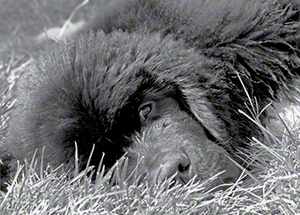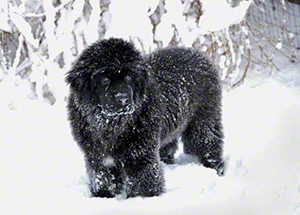The arrival of a new puppy is an exciting event, and the inevitable change in household routine will go much smoother if you’re well-prepared for the arrival of your Newfoundland newcomer. The following items and discussions should help you to get ready – or, if your puppy is already at home, to make sure you’ve covered all the bases. (If you’re not new to dog ownership, some of what’s discussed below will be familiar, but please read through the list anyway, as many of its suggestions are Newf specific. Newfoundlands’ size and breed characteristics mean that what works for a Lab or a boxer won’t necessarily fill the bill now, or at least not when your new member of the family is full-grown.)
The Crate - A Home within a Home
Dog crates are wonderful multi-function tools: they provide the dog with a “den,” a place of security and comfort which many dogs will sleep in, voluntarily, for their entire lives; crates are also invaluable for housetraining a puppy; and they are essential equipment if you later plan to travel with your dog or engage in dog-related activities. In short, get a crate. Folding wire crates are the most versatile and useful, and since many come with adjustable, removable dividers, they can be purchased to fit a full-grown Newf but still be used for housetraining a puppy – although a smaller, puppy-sized crate will be easier to accommodate as you work on housetraining your youngster. Crates with multiple doors are more useful yet. Airline crates should be avoided.
Adult Newfs vary in size; a crate that’s 42” long by 24” wide by 36” high will be sufficient for many Newfs, but the largest Newfs might require a crate that’s 54” long by 35” wide by 45” high (a Great Dane-sized crate). Dogs that will be crated for anything more than a short period of time will definitely benefit from a larger crate. In these cases, or if you plan to travel with your dog and his crate, consider getting a water bucket made specifically for wire crates; choose one that has one flat side (to help it stay out of the way), and to reduce the chance of spills get a double snap hook so you can hang the bucket from its handle. A pad for underneath the crate (to protect floors) is an excellent idea.
Crates must never be used for punishment; doing so will only confuse your dog and make your training of her harder. Crates can be effective for providing a brief period of calm when necessary, though it’s always critical to make the experience a stress-free one for the dog. Even when a dog is crated because the owner needs a break, body language and tone of voice must always be upbeat and non-threatening.
Read More About Crate Training:
- Gearing Up for Puppy - Crates
- The Importance of Crate Training
- Crate Training for Safety and Comfort

